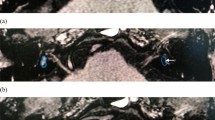Abstract
Purpose
Intratympanic injection of gadolinium diethylenetriaminepentaacetic acid (Gd-DTPA) has been reported as a procedure to visualize endolymphatic hydrops of Meniere’s disease. We frequently noted that cerebrospinal fluid (CSF) in the internal auditory canal (IAC) was also enhanced after this procedure. The purpose of this study was to evaluate how frequently this occurs and to investigate the specific features of patients who lack this communication.
Materials and methods
A total of 25 patients with clinically suspected endolymphatic hydrops underwent the procedure. After 24 h, three-dimensional fluid-attenuated inversion recovery (3D-FLAIR) and 3D constructive interference in steady state (3D-CISS) were performed. The presence of contrast enhancement in the CSF space of the fundus of the IAC was evaluated.
Results
The contrast ratio between CSF of the IAC fundus and cerebellar white matter on the injected side was 1.49 ± 0.65, and that of the noninjected side was 0.32 ± 0.16 (P < 0.01). Enhancement of the CSF space in the IAC fundus was seen in all but two subjects: one had enlarged endolymphatic duct and sac syndrome (EEDS), and the other had cochlear nerve agenesis. In these two patients, the cochlear modiolus seemed to be normal.
Conclusion
Intratympanic Gd-DTPA administration can reveal permeability of the modiolus and might facilitate evaluation of functional abnormalities of the modiolus not detected by conventional imaging tests.
Similar content being viewed by others
References
Hara A, Salt AN, Thalmann R. Perilymph composition in scala tympani of the cochlea: influence of cerebrospinal fluid. Hear Res 1989;42:265–271.
Rask-Andersen H, Schrott-Fischer A, Pfaller K, Glueckert R. Perilymph/modiolar communication routes in the human cochlea. Ear Hear 2006;27:457–465.
Duckert LG, Duvall AJ 3rd. Cochlear communication routes in the guinea pig—spiral ganglia and osseous spiral laminae: an electron microscope study using microsphere tracers. Otolaryngology 1978;86(Pt 1):ORL434–ORL446.
Walsted A. Effects of cerebrospinal fluid loss on hearing. Acta Otolaryngol Suppl 2000;543:95–98.
Zou J, Pyykko I, Counter SA, Klason T, Bretlau P, Bjelke B. In vivo observation of dynamic perilymph formation using 4.7 T MRI with gadolinium as a tracer. Acta Otolaryngol 2003;123:910–915.
Aikawa T, Ohtani I. Temporal bone findings in central nervous system leukemia. Am J Otolaryngol 1991;12:320–325.
Phelps PD, Reardon W, Pembrey M, Bellman S, Luxom L. X-linked deafness, stapes gushers and a distinctive defect of the inner ear. Neuroradiology 1991;33:326–330.
Incesulu A, Adapinar B, Kecik C. Cochlear implantation in cases with incomplete partition type III (X-linked anomaly). Eur Arch Otorhinolaryngol 2008;265:1425–1430.
Gopen Q, Rosowski JJ, Merchant SN. Anatomy of the normal human cochlear aqueduct with functional implications. Hear Res 1997;107:9–22.
Nakashima T, Naganawa S, Sugiura M, Teranishi M, Sone M, Hayashi H, et al. Visualization of endolymphatic hydrops in patients with Meniere’s disease. Laryngoscope 2007;117:415–420.
Griswold MA, Jakob PM, Heidemann RM, Nittka M, Jellus V, Wang J, et al. Generalized autocalibrating partially parallel acquisitions (GRAPPA). Magn Reson Med 2002;47:1202–1210.
Mugler JP 3rd, Bao S, Mulkern RV, Guttmann CR, Robertson RL, Jolesz FA, et al. Optimized single-slab three-dimensional spin-echo MR imaging of the brain. Radiology 2000;216:891–899.
Naganawa S, Kawai H, Fukatsu H, Ishigaki T, Komada T, Maruyama K, et al. High-speed imaging at 3 tesla: a technical and clinical review with an emphasis on whole-brain 3D imaging. Magn Reson Med Sci 2004;3:177–187.
Naganawa S, Koshikawa T, Nakamura T, Kawai H, Fukatsu H, Ishigaki T, et al. Comparison of flow artifacts between 2D-FLAIR and 3D-FLAIR sequences at 3 T. Eur Radiol 2004;14:1901–1908.
Ishida IM, Sugiura M, Naganawa S, Teranishi M, Nakashima T. Cochlear modiolus and lateral semicircular canal in sudden deafness. Acta Otolaryngol 2007;127:1157–1161.
Kendi TK, Arikan OK, Koc C. Magnetic resonance imaging of cochlear modiolus: determination of mid-modiolar area and modiolar volume. J Laryngol Otol 2004;118:496–499.
Naganawa S, Ito T, Iwayama E, Fukatsu H, Ishigaki T, Nakashima T, et al. MR imaging of the cochlear modiolus: area measurement in healthy subjects and in patients with a large endolymphatic duct and sac. Radiology 1999;213:819–823.
Lemmerling MM, Mancuso AA, Antonelli PJ, Kubilis PS. Normal modiolus: CT appearance in patients with a large vestibular aqueduct. Radiology 1997;204:213–219.
Bachor E, Byahatti S, Karmody CS. New aspects in the histopathology of the cochlear aqueduct in children. Am J Otol 1999;20:612–620.
Naganawa S, Sugiura M, Kawamura M, Fukatsu H, Nakashima T, Maruyama K. Prompt contrast enhancement of cerebrospinal fluid space in the fundus of the internal auditory canal: observations in patients with meningeal diseases on 3D-FLAIR images at 3 tesla. Magn Reson Med Sci 2006;5:151–155.
Author information
Authors and Affiliations
Corresponding author
About this article
Cite this article
Naganawa, S., Satake, H., Iwano, S. et al. Communication between cochlear perilymph and cerebrospinal fluid through the cochlear modiolus visualized after intratympanic administration of Gd-DTPA. Radiat Med 26, 597–602 (2008). https://doi.org/10.1007/s11604-008-0286-z
Received:
Accepted:
Published:
Issue Date:
DOI: https://doi.org/10.1007/s11604-008-0286-z




